Francis Amory Prize Awarded to Patrick C. Walsh
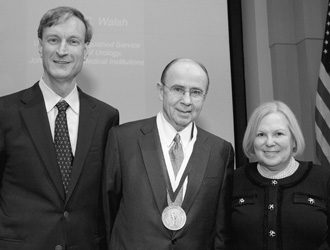
|
| David C. Page, 2012 Francis Amory Prize recipient Patrick C. Walsh, and Leslie Berlowitz |
Dr. Walsh is University Distinguished Service Professor of Urology at Johns Hopkins Medical Institutions. He served for thirty years as Director of the Brady Urological Institute, where he developed and refined a new surgical approach to radical prostatectomy. The procedure, which has been performed on hundreds of thousands of patients worldwide, dramatically reduces the most serious side effects of the surgery.
Along with colleagues at Johns Hopkins, he was the first to describe the 5 alpha-reductase enzyme deficiency, to develop an experimental technique for the induction of benign prostatic hyperplasia, to demonstrate the influence of reversible androgen deprivation on BPH, and to characterize hereditary prostate cancer.
Following the prize ceremony, Dr. Walsh participated in the Francis Amory Prize Symposium on advances in reproductive biology and medicine. He spoke about “The Impact of Anatomic Discoveries on Prostate Cancer Surgery.” The symposium also included presentations by David C. Page, Director of the Whitehead Institute, Professor of Biology at the Massachusetts Institute of Technology, and Howard Hughes Medical Institute Investigator, on “The Y Chromosome”; and by Patricia K. Donahoe, Director of Pediatric Surgical Research Laboratories and Chief Emerita of Pediatric Surgical Services at the Massachusetts General Hospital and Marshall K. Bartlett Professor of Surgery at Harvard Medical School, on “Advances in Reproductive Biology: The Impact on Disorders of Sexual Development and Ovarian Cancer.”
Members of the 2012 Francis Amory Prize Committee include Randy W. Schekman, Chair (University of California, Berkeley), David E. Clapham (Harvard Medical School; Children’s Hospital, Boston), Barbara Jean Meyer (University of California, Berkeley), David C. Page (Whitehead Institute; MIT), David W. Russell (University of Texas Southwestern Medical Center), and Leslie Berlowitz (American Academy).
The citation that was presented to Dr. Walsh reads:
Society has benefited from your pathbreaking work as a surgeon, researcher, and teacher. You have forever changed our fundamental understanding and treatment of prostate cancer. For three decades you directed the Brady Urological Institute, whose laboratories, clinics, and operating rooms produced many of the most important advances in urology and trained thousands of doctors from here and abroad. The anatomic approach to radical prostatectomy that you developed has al- lowed far more men with early-stage disease to lead normal lives.
Your characterization of the familial and genetic factors responsible for prostate cancer has broadened our understanding of the disease. You and your colleagues identified the first genetic mutation associated with inherited prostate cancer. Moreover, you have established the largest registry of men with hereditary prostate cancer, and led efforts for improved national standards for the early diagnosis and staging of the cancer.
A member of the Institute of Medicine and editorial board member of The New England Journal of Medicine, you have shared your knowledge both in professional journals and in books for the general public. The advances you have made in understanding and treating prostate cancer have galvanized research and revolutionized the field.
You have performed four thousand, five hundred and sixty-nine life-saving surgeries, and with the same commitment and laser-like focus on men’s health, you continue to be a source of healing and hope. Distinguished physician-scientist, skilled surgeon, inspired teacher, and relentless investigator, the American Academy of Arts and Sciences is proud to confer upon you the 2012 Francis Amory Prize.
Beyond Technology Report Featured at National Energy Industry Gathering
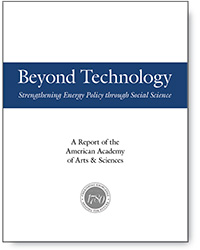 A new Academy report,
Beyond Technology: Strengthening Energy Policy through Social
Science,
was featured at the 2012 National
Electricity Forum, a meeting organized by
the U.S. Department of Energy (DOE) and
the National Association of Regulatory Utility Commissioners (NARUC) that drew
policy-makers, energy industry leaders, and
scholars from around the country to address
challenges facing the electricity industry in
the twenty-first century.
A new Academy report,
Beyond Technology: Strengthening Energy Policy through Social
Science,
was featured at the 2012 National
Electricity Forum, a meeting organized by
the U.S. Department of Energy (DOE) and
the National Association of Regulatory Utility Commissioners (NARUC) that drew
policy-makers, energy industry leaders, and
scholars from around the country to address
challenges facing the electricity industry in
the twenty-first century.
In her keynote presentation, Kelly Sims Gallagher, a member of the Academy’s Alternative Energy Future steering committee and Associate Professor of Energy and Environmental Policy at Tufts University, discussed how social science tools and analysis could help address the nontechnical barriers to implementing new energy technologies, such as the behavior of individuals, households, and institutions in adopting those technologies.
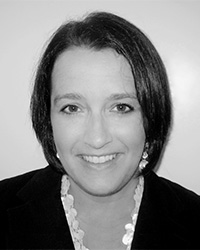
|
| Kelly Sims Gallagher |
Beyond Technology argues that as the existing technological infrastructure changes, the legal, social, and economic infrastructures will need to change, too. Indeed, the societal barriers to new technologies are often much harder to overcome than the technical barriers, particularly, as Gallagher stated, “in a country that is fractured politically and has multiple layers of governance, and where public understanding of energy-related challenges and opportunities is weak.”
Yet energy policy and planning today are inattentive to many of these nontechnical barriers. As a consequence, experimental energy projects are often poorly designed and duplicative, or they produce results that are not well analyzed or communicated to the public. “Siting of infrastructure is a classic example,” Gallagher noted. “It has become conventional wisdom here in the United States that public attitudes make it nearly impossible to implement a national vision that requires new transmission lines, new power plants, or even a single wind turbine on top of a hill.”
Social Science and the Alternative Energy FutureBeyond Technology Steering Committee Robert W. Fri (Chair), Resources for the Future Stephen Ansolabehere, Harvard University Douglas Arent, National Renewable Energy Laboratory Ann Carlson, University of California, Los Angeles Thomas Dietz, Michigan State University Kelly Sims Gallagher, Tufts University M. Granger Morgan, Carnegie Mellon University Maxine Savitz, Honeywell, Inc. (ret.) Paul C. Stern, National Research Council James L. Sweeney, Stanford University Michael P. Vandenbergh, Vanderbilt University Project StaffJohn Randell, American Academy of Arts and Sciences |
- demonstrating the value of social and behavioral research for enhancing the effectiveness of energy policy;
- encouraging the use of interdisciplinary social science research within energy programs;
- building capacity to connect the energy policy and social science communities;
- incorporating behavioral considerations into energy-related economic modeling efforts; and
- engaging state and local governments and regulatory communities to design more effective energy policies.
In thinking about policy design at the community level, Gallagher explained, social science can “turn the question upside down and ask: when and why do communities accept new energy technologies?” She described successful wind energy initiatives in New Jersey and Denmark that demonstrate how long-term visions can be implemented through effective public engagement and an emphasis on policy experimentation and evaluation.
Social science research can also shed light on consumer behavior. Studies have shown that individuals often do not conduct rational cost-benefit analyses, but rather make decisions based on other considerations. For example, it has been observed that trust is a crucial ingredient to having a successful siting outcome, and that trust can be gained and established through early, careful, and systematic stakeholder engagement and decision-making procedures.
“An intriguing consumer behavior question relates to the so-called smart grid,” Gallagher said. “We’ve seen a lot of experimentation with demand response programs. If real-time electricity pricing were available to consumers, would they adjust their consumption behavior? Would they act ‘smart’? Structured experiments could be conducted to determine what consumers are likely to do, based on recent experience and research on residential feedback programs.”
To this end, Beyond Technology encourages utilities to adopt social science-based best practices when deploying new technologies, like smart meters, whose success depends on public acceptance by individual consumers.
“Implementing any of our visions for a twenty-first-century electricity industry will require more effective implementation strategies than we have utilized in recent years,” Gallagher concluded. “Those strategies could be better informed by social science research and policy analysis, and Beyond Technology provides some useful ideas for how social science could be used to strengthen energy policy.”
Beyond Technology is based on ongoing work of the Academy’s Alternative Energy Future project, which is supported by the doe and the National Science Foundation, two anonymous foundations, and contributors to the American Academy Intellectual Venture Fund, including The Fremont Group, Kleiner Perkins Caufield & Byers, and Novartis.
Beyond Technology: Strengthening Energy Policy through Social Science is available online. More information about the Alternative Energy Future project may be found on the Academy’s website.New Publication
Dædalus on The Alternative Energy Future–Challenges for Technological Change
Spring 2012 issue of Dædalus on The Alternative Energy FutureIntroduction by Robert W. Fri (Resources for the Future) & Stephen Ansolabehere (Harvard University) “Paying Too Much for Energy? The True Costs of Our Energy Choices” by Michael Greenstone (Massachusetts Institute of Technology; Brookings Institution) & Adam Looney (Brookings Institution) “Energy Policy: Past or Prologue?” by Michael J. Graetz (Columbia Law School) “Using the Market to Address Climate Change: Insights from Theory & Experience” by Joseph E. Aldy (Harvard University) & Robert N. Stavins (Harvard University) “The American Public’s Energy Choice” by Stephen Ansolabehere (Harvard University) & David M. Konisky (Georgetown University) “Is Shale Gas Good for Climate Change?” by Daniel P. Schrag (Harvard University) “Stimulating Energy Technology Innovation” by Ernest J. Moniz (Massachusetts Institute of Technology) “Policies for Financing the Energy Transition” by Kassia Yanosek (Stanford University; Quadrant Management; Tana Energy Capital LLC) “National Policies to Promote Renewable Energy” by Mohamed T. El-Ashry (United Nations Foundation) |
Guest edited by Robert W. Fri (Resources for the Future) and Stephen Ansolabehere (Harvard University), the volume documents a multi-decade record of misdirected policy initiatives and a history of underpricing energy relative to its societal costs. The essays explore political resistance to addressing the pricing problem and identify a lack of public understanding of the link between climate change and the need to transform the energy system. In addition, the authors note that focusing on local benefits, and employing regulatory approaches rather than pricing strategies, may be the most productive approaches to building public support for cleaner energy in the short term.
But accounting for societal costs is not the only challenge facing policy-makers. A successful national energy policy must also encourage the development of affordable, reliable, and clean energy technologies. Innovation involves more than inventing new technology; it also requires that the technology diffuse throughout the economy at a sufficient scale to make a difference. The essays in the Dædalus issue offer recommendations both for stimulating innovation and for financing the widespread deployment of promising technologies.
As Fri and Ansolabehere note in their introduction to the issue, “Regardless of how the price and politics of energy play out, it will be essential to create technology that can grasp the holy grail of affordable, reliable, and clean energy.”
As a companion to this issue, the Winter 2013 issue of Dædalus will explore how societal responses to the transformation of the energy system could help or hinder the emergence of new technologies, and how social science research can be incorporated into energy-policy development.
For more information about Academy publications, visit http:// www.amacad.org/publication.aspx.
Updated Humanities Indicators Track Changes in the Disciplines
With the support of the Andrew W. Mellon Foundation and the National Endowment for the Humanities, the Humanities Indicators have become a valuable source of information about the state of the humanities, providing data to the higher education community, the media, cultural organizations, and policy-makers.
To date, the Humanities Indicators website (http://www.humanitiesindicators.org/humanitiesData.aspx) has received more than two million hits from over 100 countries, and the data have been widely cited in journalism and scholarship addressing the strengths and weaknesses of American education. The data sets currently include 75 Indicators and 213 figures and supporting tables.
“Many scholars and students in the humanities have little understanding of the sociological and cultural impact of their fields as a whole and little understanding of how the public uses the humanities in its everyday life,” said Gerald Early, Merle Kling Professor of Modern Letters at Washington University in St. Louis and Chair of the Academy Council. “But such knowledge is essential if the humanities are to make a compelling case for themselves in the twenty-first century.”
A priority of the project has been the updating of data from the original Indicators. The Academy, in cooperation with the National Opinion Research Center (NORC) at the University of Chicago, has added new data and explanatory narratives to 19 Indicators, including 58 updated figures with supporting tables and 39 figures for which revisions are now under way. Under the direction of project leader Norman Bradburn, Tiffany and Margaret Blake Distinguished Service Professor Emeritus at the University of Chicago and Senior Fellow at NORC, project staff have created a new Indicator on Study Abroad (both U.S. students studying abroad and foreign students studying in the United States), which will be posted this summer.
Among the trends highlighted by recent updates to the Indicators are:
The persistent weakness of high school history teacher preparation:
Approximately 29 percent of history students in public schools were taught by teachers with degrees and certification in history, according to data for the 2007–2008 school year. By comparison, 73 percent of students in the natural sciences were taught by certified teachers with science degrees (see Figure I-9a).
An ongoing decline in reading to children:
In 2007, only 55 percent of children ages 3 to 5 were read to by a family member each day, compared to 60 percent in 2005. The sharpest decline was seen in households in which the mother had less than a high school education – from 41 percent to 31 percent during the same period. Only children whose mothers had at least a bachelor’s degree were more likely than their 2005 predecessors to have been read to daily by a family member.
Decreasing spending on humanities and education research:
Though the decline in college and university spending on humanities research was slight, from approximately $259 million in 2007 to $253 million in 2009, the humanities and education were the only academic fields for which research expenditures were lower (see Figure IV-10a).
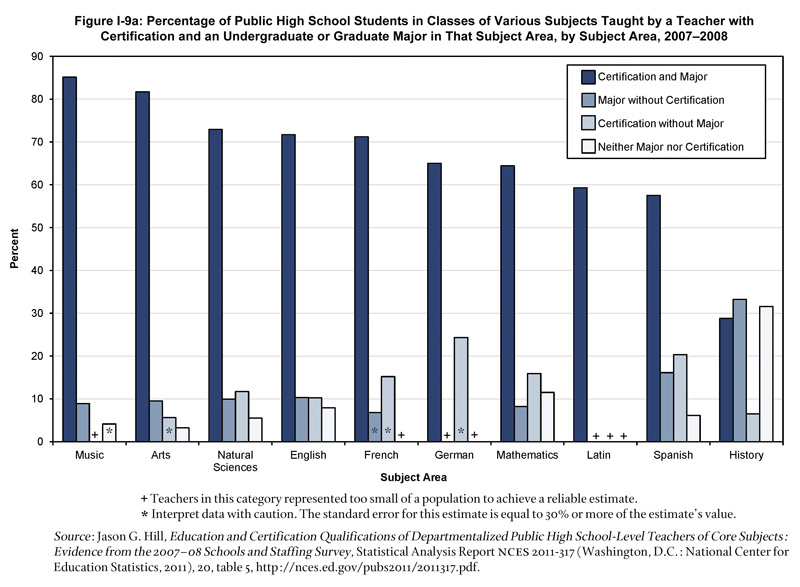
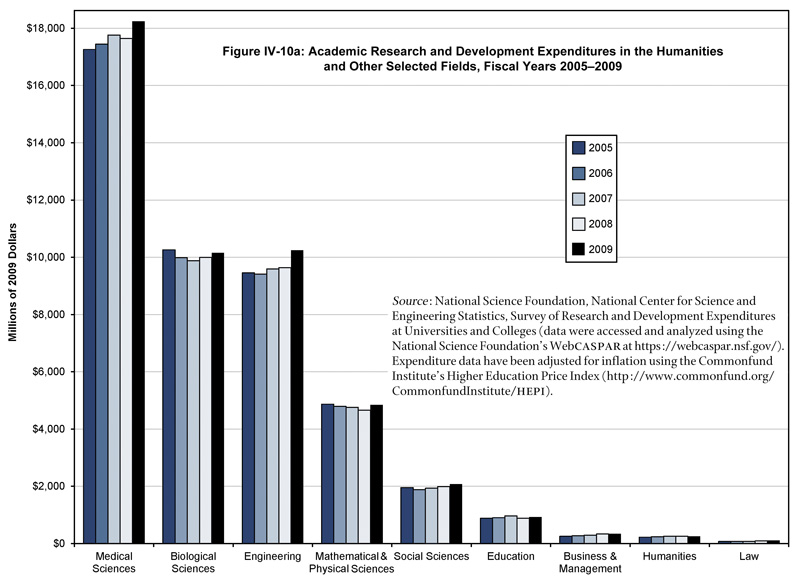
This year, the Academy will also begin a second round of data collection to update the Humanities Departmental Survey. The first survey was administered in 2007 and 2008 to over 1,400 humanities departments in the fields of history, English and literature, foreign languages, art history, linguistics, and religion. It provided baseline data reflecting the state of the humanities in colleges and universities. The second survey, to be published in 2013, will add new disciplines and enable scholars to track trends over time.
The associations participating in the second round include: American Academy of Religion, American Folklore Society, American Historical Association, American Musicological Society, American Philological Society, American Philosophical Association, College Art Association, History of Science Society, Linguistic Society of America, Modern Language Association, and the National Communication Association.
Additionally, in conjunction with the Community College Humanities Association, we will be collecting data on humanities faculty, teaching, and students at hundreds of two-year colleges; this new data will reflect an important sector of higher education comprising 44 percent of the nation’s undergraduates. Citing the importance of the project, several national learned societies – including the Modern Language Association, the American Historical Association, the Linguistic Society of America, and the American Musicological Society – are providing annual support for the Indicators and for the next round of updates to the Humanities Departmental Survey.
“The ready availability of these data serves the needs, not only of scholars and the general public, but also of policy-makers,” said Francis Oakley, Edward Dorr Griffin Professor of the History of Ideas, Emeritus, at Williams College and a member of the Oversight Committee of the Academy’s Initiative for Humanities and Culture. “It is hard now to imagine having to manage without them.”
Around the Country
Members Gather at The Getty Center
At a Stated Meeting at The Getty Center in Los Angeles on March 3, 2012, Getty curatorial staff led more than 150 Academy members and guests on tours of the Getty Museum, the Getty Research Institute, and the Getty Conservation Institute. Fellows James Cuno, President and Chief Executive Officer of the J. Paul Getty Trust, and Thomas W. Gaehtgens, Director of the Getty Research Institute, spoke about the institution’s exhibitions and collections, its global art restoration and conservation efforts, and its research program. The meeting also featured the official Induction of 16 previously elected Academy members.

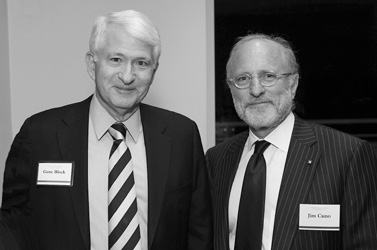
|
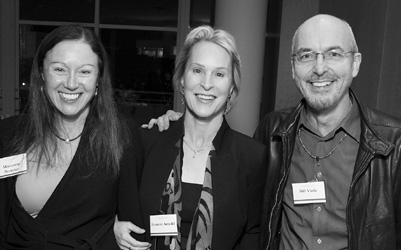
|
| Gene Block (University of California, Los Angeles) and James Cuno (J. Paul Getty Trust) |
Marianne Bronner (California Institute of Technology), Frances Arnold (California Institute of Technology), and
Bill Viola (Bill Viola Studio) |
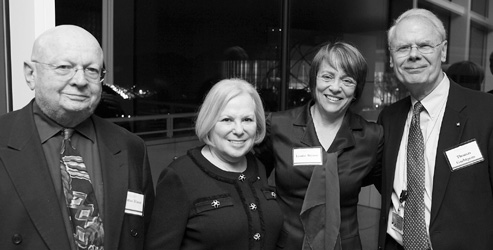
|
Thomas Hines (University of California, Los Angeles), Academy President Leslie Berlowitz, Louise Bryson (J. Paul Getty Trust), and Thomas Gaehtgens (Getty Research Institute) |